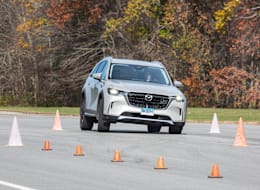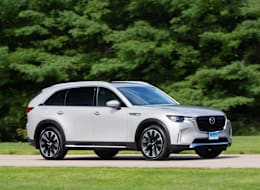The CX-90 is a three-row midsized SUV that replaces the CX-9 in Mazda’s lineup. It’s available with both gas-only and plug-in hybrid powertrains, and we tested both versions.
Plug-in hybrid electric vehicles (PHEVs) function like a hybrid, except that they have a larger battery and can be plugged into a wall outlet or an EV charger. When the battery is fully charged, they can run on mostly electric power (typically for about 20 to 40 miles, depending on the vehicle) until the battery is drained, at which point they switch to regular hybrid operation.
For buyers who are nervous about going all-in for an electric vehicle, a plug-in hybrid could be a logical and cautious step toward electrification. PHEVs make especially good sense if you have a short commute to work, rarely drive long distances, and have the ability to plug in your vehicle at home to charge overnight—it’s bound to save you lots of money at the gas pump. Plus, unlike regular hybrids, a PHEV may be eligible for federal tax credits. Also consider that the average American drives less than 40 miles per day, which means many people will be able to do most of their daily commute on electric power while reserving the gas engine for longer trips.
The CX-90 PHEV’s powertrain consists of a 2.5-liter four-cylinder gasoline engine, an electric motor, a 17.8-kilowatt-hour battery, and an eight-speed automatic transmission. Total system output is a plentiful 323 horsepower, with standard all-wheel drive.
The electric-only driving range is an EPA-estimated 25 miles, which is on the shorter side among PHEVs. After the electric range is used up, the gas engine kicks on and the CX-90 acts as a regular hybrid, getting 23 mpg overall in our testing. That’s 1-mpg less than the gas-only version we tested, so you’ll only benefit from the PHEV’s efficiency if you plan to plug in often.
As with other PHEVs, even during electric-drive sessions the gas engine will kick on occasionally, depending on the driver’s power demands as well as the outside temperature. But when it does so, the CX-90 falls short on refinement. The powertrain exhibits some noticeable shudders and hiccups, and switching between gas and electric is loud and feels clunky—you can hear the gas engine turn on. Most newer hybrids are quieter and smoother. It also may come across as odd to feel the automatic transmission upshift through its gears, even when it’s in electric mode.
Still, there’s no denying the power the CX-90 PHEV has on hand. It makes quick work of getting around slower traffic in a two-lane passing zone, giving a healthy shove down the road. That is, after a bit of a delay from the time you floor the accelerator pedal to when you feel the full might of the powertrain pieces all working in conjunction. It certainly proved quick by our numbers, sprinting from 0 to 60 mph in 6.8 seconds, which is about a half-second to the good over the regular CX-90 we tested.
It takes a little more than two and a half hours to charge the PHEV’s battery on a 240-volt connection. Owners can also get a full charge in about 12 hours if they plug in with a regular 120-volt household outlet. As with many PHEVs, the CX-90 can’t be charged at public DC fast-charging stations.
Mazda did a great job with the CX-90 PHEV’s brakes. Hybrids, PHEVs, and EVs use regenerative braking to help slow the vehicle when coasting or braking, while recouping energy to the battery. But regenerative brakes often have an unnatural feel, due to the nonlinear way that it ramps up braking force. Not so here. Our drivers found the CX-90’s brake pedal easy to modulate at all speeds, and come to a smooth stop where intended.
Like the regular CX-90, the PHEV stands out for its handling agility, which resembles a sports sedan more than a substantial three-row SUV. It’s a big vehicle, but tight body control blended with good steering feedback makes for a sporty edge. On our test track, the big Mazda not only felt secure through our tough avoidance-maneuver test, but was also enjoyable to fling around our twisty road course. That said, drivers will notice a somewhat slow steering response through tight corners at low speeds, as well as while parking.
Mazda would like potential customers to view the CX-90 as a bargain luxury vehicle, as a competitor to a Lexus or BMW, but it’s not quite there yet in terms of ride comfort and noise isolation. Big wheels and tires can make for a stiff ride, and our midlevel Premium trim’s 21-inch setup allowed bumps to punch through in a serious way. Our advice: Stick with the Preferred trim, which comes with 19-inch tires.
The cabin also isn’t up to luxury standards when it comes to noise. The electric motor has more of a whine than many PHEVs, and wind noise at highway speeds is noticeable. Further, the four-cylinder engine isn’t the most pleasant-sounding, especially when called upon for an extra burst of speed.
The front seats are comfortable with just enough lateral support to hold you in place when taking corners with some tenacity. The driving position is nicely sorted, with lots of headroom, an excellent view of the gauges, and well-placed armrests. The wide center console tends to hem in the driver’s right knee, but we appreciate that it’s padded there. Both seven- and eight-passenger seating configurations are available; the former gets two captain’s chairs in the middle row. Those in the second row will find a roomy and comfortable place to spend time, but the third-row seat’s low perch and tight foot space makes it best-suited for kids.
The cabin adheres to Mazda’s uncluttered elegance design work, with lots of padded surfaces, high-quality switchgear, and contrasting stitching. Top-end trims look even more impressive, thanks to an abundance of suede and higher-quality leather. Small-item storage up front is lacking compared to similar SUVs, with an oddly shallow bin underneath the center armrests. Cargo space is decent for the segment, though—similar to the Honda Pilot and Toyota Highlander—and we’re happy to report that the PHEV’s maximum cargo volume is unchanged from the regular CX-90.
The most serious knock against any CX-90—PHEV or gas-only—is the odd design of some of its controls. For starters, the infotainment display screen isn’t touch-enabled like in most vehicles, except when using Android Auto or Apple CarPlay on higher trims. And interacting with the center controller knob and on-screen menus is complicated due to the multiple layers you have to wade through. The electronic gear selector is also frustrating, thanks to its illogical upside-down L-shaped pattern—shifting the CX-90 into Park requires an extra flick of the wrist to the left.
All CX-90s come standard with automatic emergency braking with pedestrian and bicyclist detection, automatic emergency braking that operates at highway speeds, blind spot warning, rear cross traffic warning, lane departure warning, lane keeping assistance, adaptive cruise control, and automatic high beams.


























